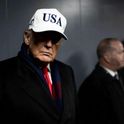The US economy has now expanded for 121 consecutive months, making the current upswing the longest in the country’s history. There are two potential explanations. To a few exuberant observers, this landmark indicates that we have entered a new era in which downturns are a thing of the past. Actually, Australia and not the US epitomises this possibility. The “Lucky Country” is currently experiencing its 28th consecutive year of economic growth.
A more sceptical view is that the US expansion reflects good luck rather than good policy. This luck starts with relatively stable oil prices. It includes the fact that home prices haven’t soared as in 2001-07, when they set the stage for the subsequent crash. US banks remain cautious about taking risks, so there have been no major bank failures to interrupt the expansion. These last developments may reflect the not-so-happy fact that this expansion occurred in the wake of a sobering financial crisis. But they have been stabilising nonetheless.
Finally—and what I want to pay most attention to—the current expansion hasn’t been choked off by higher interest rates. Scholars agree that US expansions die not of old age but by Federal Reserve action. Concerned about accelerating inflation, the Fed tightens. Asset prices and investment weaken in response, and recession eventually follows. This time is different, to coin a phrase. For this there are three potential explanations: good policy, good luck, and Donald Trump. Good policy means that Fed officials now realise that past expansions were killed off by the central bank’s own malfeasance. That a substantial number of Federal Open Market Committee (FOMC) members have academic credentials means that more of them are aware of scholarship documenting this fact.
This, of course, could be attributing undue influence to “academic scribblers.” The main factor behind the Fed’s reluctance to tighten, it can be argued, is, rather, Donald Trump. Trump is a “low-interest-rate person.” His critical tweets are designed to pressure the Fed to reduce interest rates. Whether they have had any such effect is dubious, however. In practice, the FOMC is as likely to raise rates to assert its independence as it is to lower them to avoid Trump’s criticism. On balance, it is unlikely to do either.
The good-luck interpretation is that the Fed has been blessed, for mysterious reasons, by subdued inflation. Hourly wages are rising by just 3.1 per cent, despite an unemployment rate of 3.6 per cent, the lowest level in fully 50 years. As the Eagles said in “Hotel California,” “we haven’t had that spirit here since 1969.”
Final-goods inflation depends on the difference between the increase in wages and increase in labour productivity—the change in what economists call unit labour costs. And with the rate of productivity growth running at 1.5 per cent, current wage growth is simply too little to get final-goods inflation up to the Fed’s 2 per cent target. Hence the central bank remains on hold.
In fact, the weakness of wage growth is no mystery. Wage inflation is weak because labour-market slack remains greater than indicated by a 3.6 per cent headline official unemployment rate. Include also individuals with part-time and sporadic employment (“persons marginally attached to the labour force, plus total employed part time for economic reasons”), and unemployment rises to 7.1 per cent. Even now, in other words, not all those who dropped out of the labour force due to the Great Recession and the opioid crisis have dropped back in. The existence of this reserve army of potential workers keeps a lid on wages.
In addition, trade unions no longer force big US corporations to share their profits when the latter rise in expansions. Historically, unions could threaten to halt production if companies failed to share their “rents.” A famous example from the mid-20th century was the Treaty of Detroit, when car-makers negotiated the first in a series of generous five-year pacts with the United Auto Workers. But today, with the demise of unions, those “rents” accrue to the CEO and shareholders, not to employees.
Given all this, how might the current expansion end? Most obviously, there could be a geopolitical shock that causes oil prices to spike and investment to slump. This could erupt in the Strait of Hormuz, but given the Trump Administration’s erratic foreign policies, one can’t rule out geopolitical events on the Korean Peninsula, in the South China Sea, and in Venezuela.
Or there may come a point where the reserve army of the unemployed is finally depleted and wages rise sharply. The Fed would respond by jacking up interest rates, even at the risk of precipitating a recession, whether President Trump likes it or not.
What are odds of the expansion ending in the next year? Truth is that no one knows. But it is telling that, after 28 years of uninterrupted growth, the Australian expansion is now faltering. Maybe the Lucky Country is the canary in the coalmine.
How the US economy’s luck runs out
Its 121-month expansion won’t last forever but what could bring on a downturn?
July 05, 2019

The US Federal Reserve. Photo: Liu Jie/Xinhua News Agency/PA Images












